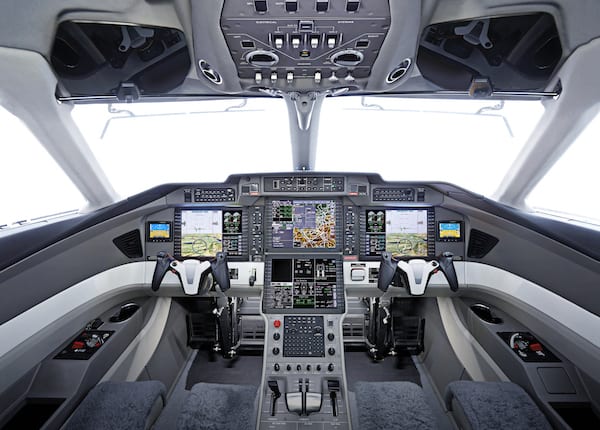
A Piliatus PC-24 cockpit. Photo courtesy of Pilatus
Over the next five years, 87% of newly purchased business jets are expected to require satellite communications technology to facilitate internet connectivity.
According to the 2018 business aviation forecast published by Honeywell Aerospace, business jet manufacturers are projected to deliver 7,700 new aircraft valued at $251 billion over the next 10 years. The forecast includes a survey and interviews with 1,575 non-fractional business jet operators globally that operate 4,400 aircraft — or about 13% of the global in-service fleet.
“87% of all dollars will be spent on large cabin aircraft,” Gaetan Handfield, Honeywell’s senior manager of marketing analysis, told Avionics International.
The forecast also notes that deliveries of new business jets in 2019 are expected to be higher than in 2018. Handfield said deliveries in 2018 are expected to be flat or lower in comparison to 2017’s 640 deliveries. That increase is driven by new models entering into service in 2018 and 2019, according to Handfield.
The majority of the new models entering service this year and in 2019, such as the Pilatus PC-24, Gulfstream G500 and Textron’s Citation Longitude, are all capable of flying international oceanic routes where the only type of connectivity available would come from satellites.
Honeywell’s survey also asked respondents about the type of features they want to see on large cabin jets. The results were divided into two categories: operational needs and concerns. On the “needs” category, the majority of respondents seek modern avionics, cruise speeds higher than Mach .85 and extended range. In contrast, the majority of respondents to the operational concerns category want to experience improved fuel economics, high-speed connectivity and optimized aircraft maintenance support.
Satellite and air-to-ground connectivity providers have been increasingly diversifying the options available to business jet operators as well. For example, Iridium is starting to add new value-added manufacturers and service providers for its Certus broadband services offering.
Certus is the company’s new multi-service communications platform with airplane terminals being supplied by the likes of Cobham, Gogo, Rockwell Collins and Thales, among others. The terminals can operate on legacy Iridium satellites as well as the speedier Iridium Next constellation.
ViaSat demonstrated its fourth-generation global aero terminal 5510 at NBAA 2017 with a modem capable of delivering up to 1 gigabit per second (gbps) speeds to aircraft. The California-based satellite service provider is also expected to unveil new connected business jet technology at NBAA 2018.
Inmarsat also expects to offer its European Aviation Network (EAN) satellite and LTE-based ground network to business jet operators by January 2019. Air-to-ground 4G LTE provider SmartSky Networks earned its first supplemental type certificate in January and is targeting business jet and commercial operators in the U.S.
The Honeywell forecast also reported some interesting regional trends. Handfield noted that purchasing plans for the next five years are higher in North America and Europe, and lower in the Asia Pacific, Middle East and Latin American regions.
Purchasing plans in Europe increased significantly, with 33% of the in-service fleet expected to be replaced over the course of the 10-year forecast period.
“If we look at last year, I think there was still a lot of Brexit anxiety in the results,” said Handfield, referring to the European respondents.
“The economy in Europe is doing a little better than last year, but also I think Brexit negotiations are happening and people are starting to see a better solution on the horizon. I think that helped a lot to improve intentions in Europe especially in England and Germany where purchasing plans were up significantly,” said Handfield.